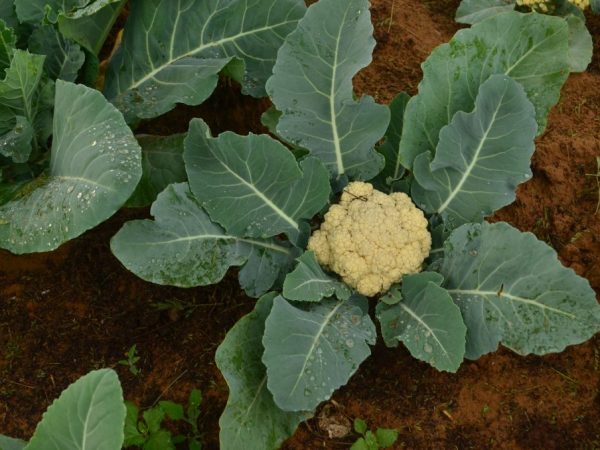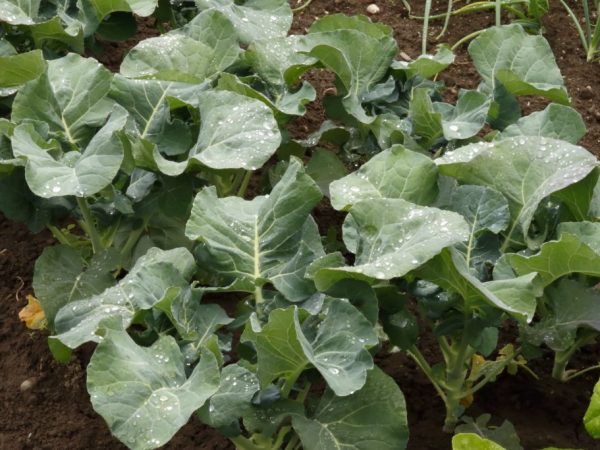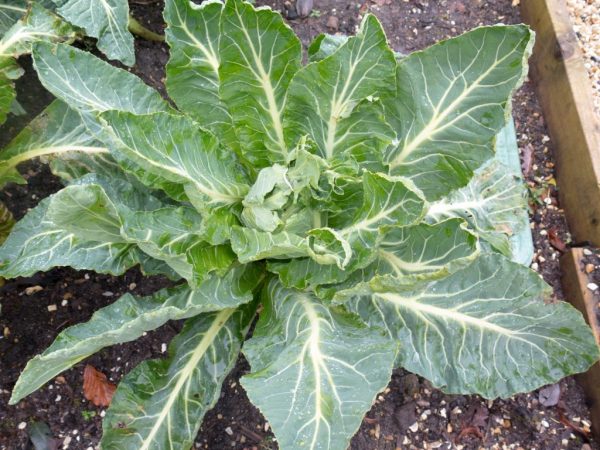Cauliflower dressing
Feeding cauliflower is a basic requirement when caring for it. Lack of fertilizers and moisture leads to a significant decrease in yield and crop death.

Cauliflower dressing
Plant characteristic
The cauliflower stems are cylindrical in shape, rather long, reaching 70 cm. Leaves are greenish with elongated petioles, on the surface of which a waxy bloom forms. Blossoming yellow.
Mature bushes have white inflorescences framed by green leaves. The heads of cabbage contain a large amount of nutrients. Cauliflower can be eaten raw or cooked and is much more digestible than other vegetables.
Site selection and soil preparation
This type of cabbage is especially demanding for seedbed preparation. Particular attention is paid to the choice of a site for planting. It is preferable if onions, root vegetables, cucumbers or early potatoes used to grow on this place.
Organic matter and minerals are added to the soil already before planting, but not heavy in texture. If the soil is heavy, they resort to frequent loosening of the row spacings. Cauliflower should be fed based on the composition of the land for planting, the method of planting and the region of the country.
How to fertilize seedlings
Before sowing, the seeds are calibrated, pickled and soaked in a solution with microelements. The lack of trace elements has a detrimental effect on the culture. As a result, leaf deformation, decay, hollowness of the stalk and poor development of the heads occur.
Foliar dressing avoids these problems. This method of application provides the plant with nutrition and prevents the occurrence of various diseases. For processing in this way, the following solution is prepared:
- 2 g boric acid;
- 5 g ammonium molybdenum;
- 10 liters of water.
Seedlings are well stirred and sprayed. Acid and ammonium are measured without exceeding the dosage.
A mixture of boron and molybdenum in the calculation of 2.5 g per 10 liters of water prevents overgrowth of sheet plates. A greenhouse frame requires 1 liter of solution.
If there is a problem with lime material in the soil, lime fertilizer (30-50 g) is added to each hole, combining it with organic. Calcareous substances include calcareous tuff, ground limestone, dolomite flour.
Fertilization with a seedless planting method

After fertilization, the plants are watered
The seeds are calibrated, disinfected and processed in a solution of trace elements. The preparation of the soil is carried out carefully so that there are no lumps and large pieces of earth.
Sowing is carried out by the nesting method at an early date. In case of drought, mulch with peat, humus. This is done in a thin layer to protect against crusting and moisture loss. After disembarkation, the method of introducing nutrients is chosen.
In dry form, the drug is simply scattered. In this version, for 1 m², you need:
- 20-25 g of ammonium nitrate;
- 15-30 g superphosphate;
- 10 g of potassium fertilizer.
Before and after applying the preparations, the soil is well soaked. The sprinkling method is the most suitable for this method of fertilizing, because the solution accidentally hitting the leaves damages them, and they will simply wash off under water without having time to cause harm. It is important to water immediately after feeding.
There is another safe way - applying the nutrient solution under the root. It is used in all weather conditions. Solution composition:
- 10 liters of water;
- 30 g of ammonium nitrate;
- 40 g superphosphate;
- 20 g of potash fertilizers.
The volume of the solution is calculated based on the number of plants. 1 liter is poured under the bush. Lack of water and nutrients, especially at the time of setting the head, leads to the formation of small fragile fruits.
Further care consists in periodic watering, loosening and hilling. The first hilling is carried out when 6-7 developed leaves are formed, after 10-14 days the process is repeated.
Top dressing during growth

Nutrient solution helps the heads to form
Plants assimilate the bulk of nutrients (up to 80%) in the process of head formation (in 20 days). The fast growth rates of the yield formation determine the high demand for the conditions of mineral and organic nutrition. At stage 1 (head tying), the nutrient solution contains:
- ammonium nitrate - 15-20 g per 1 m²;
- superphosphate - 20-25 g per 1 m²;
- potash fertilizer - 10-15 g per 1 m².
It is possible to replace organic bait with granular, liquid or dry. They are purchased in specialized stores. These include:
- liquid extract of cow or horse manure: Kaury, Biud, Bucephalus;
- chicken droppings in granules;
- complex specialized fertilizers: Agricola, Kaliyphos-N, Hera for Cabbage, Cabbage.
The alternation of organic and mineral substances is useful. This strengthens the root system of the plant.
In order for all plants to develop in the same way, fertilizing is made fractional and watered at the same time. The solution must be weak. For fractional dressings, the following scheme is used: the total number of useful components is divided by the number of treatments.
Dusting with ash is another way to feed plants and improve their quality. At the same time, ash also protects cabbage from pests. The calculation is made according to the following scheme: 1 glass per 1 m².
Acidic soils are treated in the following way: potassium nitrate is added every 14 -21 days at the rate of 3 tbsp. l. 10 liters of water for each plant. The last feeding is carried out no later than 10-12 days after tying the head, so as not to deteriorate the quality and not to exceed the content of nitrates.
Signs of a lack of nutrition
- Top dressing is necessary when the plant lacks certain substances.
- Lack of nitrogen is manifested by a change in the color of the leaves: they acquire a pale green tint, the lower leaves turn blue or red.
- With a lack of phosphorus, the formation of a head of cabbage is delayed, the leaves become smaller, their color changes to dark green with purple veins.
- Lack of potassium is manifested by yellowing of the leaves from the top and along the edges to the bottom, followed by withering away.
- The lack of magnesium is noticeable by the way the top of the leaf begins to lighten, remaining green along the veins.
- If there is not enough molybdenum, the leaves develop poorly, the head does not tie. Older leaves have a chlorotic color. In the later stages, the absence of molybdenum leads to deformation of young leaves. Symptoms are similar to stalked mosquito injury. This is especially evident on swampy and acidic soils.
Conclusion
The key to obtaining a high-quality harvest is the timely introduction of mineral and organic fertilizers, taking into account the planting method. Failure to comply with the order of nutrition, temperature and humidity leads to the formation of blooms and scattering of the head. Knowledge and careful care help to avoid many mistakes and achieve high-quality results.


